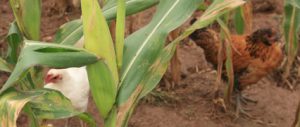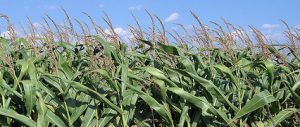My team of botanists at the Chinese Academy of Sciences has completed test plantings of organic wheat at the Hongyi Organic Farm in the eastern province of Shandong, with exciting results: for every mu of land(around 667 square metres), the farm harvested 480.5 kilograms of wheat. In 2010, the test field produced 547.9 kilograms of corn per mu.That means the plot can produce a total annual harvest of more than one tonne of grain.
Shandong has been gripped by severe drought this year. Where fertiliser, pesticides and herbicides were used, even the best harvests yielded only 250 to 300 kilograms of grain; the worst, a couple of sacks. Some farmers have been left staring at their sparsely growing wheat and wondering if they should just give up.
Some years ago, I proposed that China make efforts to develop its organic farming, or eco-farming sector, but was told that people would starve as a result. Agricultural experts have continued to spread that idea, and many academics and officials have accepted it unquestioningly. As a result, ecologists have shied away from eco-farming, while biotech experts continue to rave that genetically modified crops are the only possible solution to China’s food security issues.
In 2007, my research team started experimenting in a field in Jiangjiazhuang, in Shandong’s Pingyi county. This was the worst land in the village, leased to us for only 110 yuan (US$17) per mu – a plot of the same size on good land near the village would have cost 300 yuan (US$46). The ground was rocky, and the soil only 20-centimetres deep. Thirty years ago, the community had used this piece of land as a threshing ground, since not much could be grown on it.
It was this kind of land on which our team of scientists started trialling organic methods, strictly avoiding the use of man-made fertiliser, pesticide, herbicide, additives (manure from pig and chicken farms are polluted with additives), agricultural membrane and GM technology. Five years later, production has clearly increased. Even the locals find it hard to believe this organic miracle. Zhou Jinglin, secretary of the local Communist Party branch, told a reporter from Shandong’s television network about the changes in detail. And, having seen the trial for themselves, nearby farmers have become more enthusiastic about eco-farming.
The methods used by the Chinese Academy of Sciences experts included: taking straw normally burnt off by farmers and processing it into fodder for cows, saving 1,500 yuan to 2,000 yuan (US$232 to US$309) per head of cattle; using some of the cow manure to make methane, to be used as an energy source, and the rest as quality organic fertiliser for the fields; and tackling pests with “physical and biological” methods – for example, insect light traps were used all year round, and chickens were kept in the field and fed on the insects. Weeds were hoed up and used as organic fodder for geese, fish and locust farming; and appropriate levels of irrigation used to maintain soil moisture. These methods allowed ecological restoration of unproductive land that had been polluted with fertiliser, pesticide and herbicide and allowed production levels to increase.
In future, it should be simple to make eco-farming profitable – and the method for achieving this is straightforward: simply double the price of truly organic grains to over four yuan (US$0.6) per kilogram. Then the farmers will follow the scientists, and profits from farming will increase from about 1,000 yuan (US$155) per mu today to about 3,000 yuan (US$464) per mu.
If the government passed that increase in price directly on to farmers, China’s food security would be assured without polluting the environment. For an investment of only one trillion yuan (US$154.6 billion), China’s government could prevent farmers abandoning their farms and reduce imports of genetically modified foods. That is only one third of the spending earmarked for pollution and environmental management during the 12th Five-Year Plan period. In highly polluted areas, agricultural nonpoint source pollution (such as agricultural runoff) accounts for 70% of total pollution – much more than emissions from industry. Widespread eco-farming would help to put an end to this kind of contamination, as well as greatly reducing the sector’s greenhouse-gas emissions (it is more energy efficient than conventional agriculture).
Agricultural experts will pay any price to obtain higher theoretical yields – with large quantities of fertiliser, pesticide and herbicide, they can achieve wheat harvests as high as 700 kilograms per mu in trials. But these kinds of yields are restricted to scientific experiments and, since they make no profit, mean nothing to farmers who simply want to increase their income.
Eco-farming is essential for the future survival and progress of humanity – without it, harmonious urban-rural development is impossible. The United States is blazing a trail in this regard: it has energetically developed eco-farming as a way of boosting health and protecting the environment. Between 1992 and 2008, the number of US government-certified organic farms increased more than threefold, from 3,857 to 12,941.
And, although initial investment in an organic farm is higher than for a conventional farm, the benefits are clear – the average turnover of an organic farm in the United States is US$217,000 (1.4 million yuan) compared to just US$135,000 (873,000 yuan) for all farms. In 2007, US organic farms with sales of US$1 million or above provided the vast majority (73% according to a report by researchers at the University of California) of the country’s total organic produce. While more and more US consumers are eating organically produced food, in China today, less than 0.01% of the population has access to the same: there is a bright future for this market.
Raising food production through the use of organic fertiliser would allow low-yield fields to become medium-yield, and medium-yield fields to become high-yield, while high-yield fields would consistently be able to produce more than one-tonne of grain. Stabilising high-yield fields at this level would mean 600 million mu of good quality agricultural land could produce 600 million tonnes of grain – more than China’s current total production of 500 million tonnes. China has wide areas of land where two crops can be grown in a single year (so-called “double cropping”): all of Henan, Shandong and Jiangsu, in east China, parts of Hebei and Shanxi in the north, as well as Shaanxi further west and the provinces in the middle and lower reaches of the Yangtze River, all have the necessary warmth and rain.
Unfortunately, China’s government and scientists are currently placing their hopes for future food security in increasing the yield of a single harvest – planting so-called “super crops”, such as “super rice”, “super wheat” and “super corn”. But in reality, grain-harvested areas are shrinking and farmers are leaving the land due to their losses. If this trend cannot be reversed, then better strains of crops will be of no use.
Currently, the Chinese government’s investment in eco-farming and organic research is, when compared to the 24-billion yuan (US$3.7 billion) budget for developing genetically modified crops, virtually zero. Agricultural resources are rising in price, grain imports are increasing and funds intended to benefit farmers often do not reach them. Moreover, there is a gap between agricultural research and actual yields, and farmers are less and less inclined to plant grain crops.
It is time the Chinese government took another look at organic agriculture. By employing effective methods, boosting farmers’ enthusiasm for grain crops, nurturing the land at the same time as using it and assuring agricultural businesses can make a profit, the Chinese people can bring China’s food supply under their own control.
Jiang Gaoming is chief researcher at the Chinese Academy of Sciences’ Institute of Botany.
Homepage image from Hongyi Organic Farm


